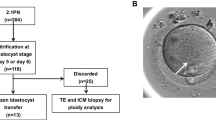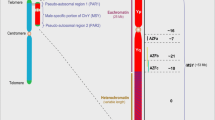Abstract
The role of partial AZFc deletions of the Y chromosome in spermatogenic impairment is currently debated. Recently, it was also reported that duplications of the same region are associated with oligozoospermia in Han-Chinese men. The aims of this study were (1) to evaluate the clinical significance of partial AZFc deletions in a large study population and (2) to define if partial AZFc duplications are a risk factor for spermatogenic failure also in a Caucasian population such as the Italian. We screened 556 infertile patients and 487 normozoospermic controls for partial AZFc deletions with a combined method based on STS+/− followed by CDY1-DAZ gene dosage and copy analysis. For the second aim, we performed CDY1-DAZ gene dosage in 229 infertile patients and 263 normozoospermic controls. The frequency of gr/gr deletions in patients was significantly different from the controls (3.2 vs. 0.4%, respectively; P < 0.001), with an OR = 7.9 (95% CI 1.8–33.8). b2/b3 deletions were rare in both groups (0.5% in patients, 0.2% in controls). Concerning gr/gr duplications, we observed no significant differences in their frequency between cases (2.6%) and controls (3.8%). This is the largest study population in the literature in which all potential methodological and selection biases were carefully avoided to detect the clinical significance of partial AZFc deletions and duplications. Our study provides strong evidence that gr/gr deletion is a risk factor for impaired spermatogenesis, whereas we did not detect a significant effect of b2/b3 deletions and partial AZFc duplications on spermatogenesis in this Caucasian ethnic group.

Similar content being viewed by others
References
de Carvalho CM, Zuccherato LW, Bastos-Rodrigues L, Santos FR, Pena SD (2006a) No association found between gr/gr deletions and infertility in Brazilian males. Mol Hum Reprod 12:269–273
de Carvalho CM, Zuccherato LW, Fujisawa M, Shirakawa T, Ribeiro-dos-Santos AK, Santos SE, Pena SD, Santos FR (2006b) Study of AZFc partial deletion gr/gr in fertile and infertile Japanese males. J Hum Genet 51:794–799
de Llanos M, Ballesca JL, Gazquez C, Margarit E, Oliva R (2005) High frequency of gr/gr chromosome Y deletions in consecutive oligospermic ICSI candidates. Hum Reprod 20:216–220
Ferlin A, Tessari A, Ganz F, Marchina E, Barlati S, Garolla A, Engl B, Foresta C (2005) Association of partial AZFc region deletions with spermatogenic impairment and male infertility. J Med Genet 42:209–213
Fernandes S, Huellen K, Goncalves J, Dukal H, Zeisler J, Rajpert De Meyts E, Skakkebaek NE, Habermann B, Krause W, Sousa M, Barros A, Vogt PH (2002) High frequency of DAZ1/DAZ2 gene deletions in patients with severe oligozoospermia. Mol Hum Reprod 8:286–98
Fernando L, Gromoll J, Weerasooriya TR, Nieschlag E, Simoni M (2006) Y-chromosomal microdeletions and partial deletions of the Azoospermia Factor c (AZFc) region in normozoospermic, severe oligozoospermic and azoospermic men in Sri Lanka. Asian J Androl 8:39–44
Giachini C, Guarducci E, Longepied G, Degl’Innocenti S, Becherini L, Forti G, Mitchell MJ, Krausz C (2005) The gr/gr deletion(s): a new genetic test in male infertility? J Med Genet 42:497–502
Giachini C, Nuti F, Marinari E, Forti G, Krausz C (2007) Partial AZFc deletions in infertile men with cryptorchidism. Hum Reprod 22:2398–2403
Hucklenbroich K, Gromoll J, Heinrich M, Hohoff C, Nieschlag E, Simoni M (2005) Partial deletions in the AZFc region of the Y chromosome occur in men with impaired as well as normal spermatogenesis. Hum Reprod 20:191–197
Imken L, El Houate B, Chafik A, Nahili H, Boulouiz R, Abidi O, Chadli E, Louanjli N, Elfath A, Hassar M, McElreavey K, Barakat A, Rouba H (2007) AZF microdeletions and partial deletions of AZFc region on the Y chromosome in Moroccan men. Asian J Androl 9:674–678
Ioannidis JP, Ntzani EE, Trikalinos TA, Contopoulos-Ioannidis DG (2001) Replication validity of genetic association studies. Nat Genet 29:306–309
Krausz C, Degl’Innocenti S (2006) Y chromosome and male infertility: update, 2006. Front Biosci 11:3049–3061
Krausz C, Giachini C (2007) Genetic risk factors in male infertility. Arch Androl 53:125–133
Lahn BT, Page DC (1999) Retroposition of autosomal mRNA yielded testis-specific gene family on human Y chromosome. Nat Genet 21:429–433
Lahn BT, Tang ZL, Zhou J, Barndt RJ, Parvinen M, Allis CD, Page DC (2002) Previously uncharacterized histone acetyltransferases implicated in mammalian spermatogenesis. Proc Natl Acad Sci USA 99:8707–8712
Lardone MC, Parodi DA, Ebensperger M, Penaloza P, Cornejo V, Valdevenito R, Pommer R, Castro A (2007) AZFc partial deletions in Chilean men with severe spermatogenic failure. Fertil Steril 88:1318–1326
Lin YW, Hsu LC, Kuo PL, Huang WJ, Chiang HS, Yeh SD, Hsu TY, Yu YH, Hsiao KN, Cantor RM, Yen PH (2007) Partial duplication at AZFc on the Y chromosome is a risk factor for impaired spermatogenesis in Han Chinese in Taiwan. Hum Mutat 28:486–494
Lynch M, Cram DS, Reilly A, O’Bryan MK, Baker HW, de Kretser DM, McLachlan RI (2005) The Y chromosome gr/gr subdeletion is associated with male infertility. Mol Hum Reprod 11:507–512
Machev N, Saut N, Longepied G, Terriou P, Navarro A, Levy N, Guichaoua M, Metzler-Guillemain C, Collignon P, Frances AM, Belougne J, Clemente E, Chiaroni J, Chevillard C, Durand C, Ducourneau A, Pech N, McElreavey K, Mattei MG, Mitchell MJ (2004) Sequence family variant loss from the AZFc interval of the human Y chromosome, but not gene copy loss, is strongly associated with male infertility. J Med Genet 41:814–825
Navarro-Costa P, Pereira L, Alves C, Gusmao L, Proenca C, Marques-Vidal P, Rocha T, Correia SC, Jorge S, Neves A, Soares AP, Nunes J, Calhaz-Jorge C, Amorim A, Plancha CE, Goncalves J (2007) Characterizing partial AZFc deletions of the Y chromosome with amplicon-specific sequence markers. BMC Genomics 8:342
Noordam MJ, Repping S (2006) The human Y chromosome: a masculine chromosome. Curr Opin Genet Dev 16:225–232
Ravel C, Chantot-Bastaraud S, El Houate B, Mandelbaum J, Siffroi JP, McElreavey K (2006) GR/GR deletions within the azoospermia factor c region on the Y chromosome might not be associated with spermatogenic failure. Fertil Steril 85:229–231
Reijo R, Lee TY, Salo P, Alagappan R, Brown LG, Rosenberg M, Rozen S, Jaffe T, Straus D, Hovatta O et al (1995) Diverse spermatogenic defects in humans caused by Y chromosome deletions encompassing a novel RNA-binding protein gene. Nat Genet 10:383–393
Repping S, Skaletsky H, Brown L, van Daalen SK, Korver CM, Pyntikova T, Kuroda-Kawaguchi T, de Vries JW, Oates RD, Silber S, van der Veen F, Page DC, Rozen S (2003) Polymorphism for a 1.6-Mb deletion of the human Y chromosome persists through balance between recurrent mutation and haploid selection. Nat Genet 35:247–251
Repping S, van Daalen SK, Korver CM, Brown LG, Marszalek JD, Gianotten J, Oates RD, Silber S, van der Veen F, Page DC, Rozen S (2004) A family of human Y chromosomes has dispersed throughout northern Eurasia despite a 1.8-Mb deletion in the azoospermia factor c region. Genomics 83:1046–1052
Rosser ZH, Zerjal T, Hurles ME, Adojaan M, Alavantic D, Amorim A, Amos W, Armenteros M, Arroyo E, Barbujani G, Beckman G, Beckman L, Bertranpetit J, Bosch E, Bradley DG, Brede G, Cooper G, Corte-Real HB, de Knijff P, Decorte R, Dubrova YE, Evgrafov O, Gilissen A, Glisic S, Golge M, Hill EW, Jeziorowska A, Kalaydjieva L, Kayser M, Kivisild T, Kravchenko SA, Krumina A, Kucinskas V, Lavinha J, Livshits LA, Malaspina P, Maria S, McElreavey K, Meitinger TA, Mikelsaar AV, Mitchell RJ, Nafa K, Nicholson J, Norby S, Pandya A, Parik J, Patsalis PC, Pereira L, Peterlin B, Pielberg G, Prata MJ, Previdere C, Roewer L, Rootsi S, Rubinsztein DC, Saillard J, Santos FR, Stefanescu G, Sykes BC, Tolun A, Villems R, Tyler-Smith C, Jobling MA (2000) Y-chromosomal diversity in Europe is clinal and influenced primarily by geography, rather than by language. Am J Hum Genet 67:1526–1543
Rozen S, Skaletsky H, Marszalek JD, Minx PJ, Cordum HS, Waterston RH, Wilson RK, Page DC (2003) Abundant gene conversion between arms of palindromes in human and ape Y chromosomes. Nature 423:873–876
Skaletsky H, Kuroda-Kawaguchi T, Minx PJ, Cordum HS, Hillier L, Brown LG, Repping S, Pyntikova T, Ali J, Bieri T, Chinwalla A, Delehaunty A, Delehaunty K, Du H, Fewell G, Fulton L, Fulton R, Graves T, Hou SF, Latrielle P, Leonard S, Mardis E, Maupin R, McPherson J, Miner T, Nash W, Nguyen C, Ozersky P, Pepin K, Rock S, Rohlfing T, Scott K, Schultz B, Strong C, Tin-Wollam A, Yang SP, Waterston RH, Wilson RK, Rozen S, Page DC (2003) The male-specific region of the human Y chromosome is a mosaic of discrete sequence classes. Nature 423:825–837
Stouffs K, Tournaye H, Van der Elst J, Haentjens P, Liebaers I, Lissens W (2008) Do we need to search for gr/gr deletions in infertile men in a clinical setting? Hum Reprod 23:1193–1199
Tuttelmann F, Rajpert-De Meyts E, Nieschlag E, Simoni M (2007) Gene polymorphisms and male infertility—a meta-analysis and literature review. Reprod Biomed Online 15:643–658
World Health Organization (1999) WHO laboratory manual for the examination of human semen and sperm-cervical mucus interaction, 3rd edn. Cambridge University Press, Cambridge, pp 4–33
Wu B, Lu NX, Xia YK, Gu AH, Lu CC, Wang W, Song L, Wang SL, Shen HB, Wang XR (2007) A frequent Y chromosome b2/b3 subdeletion shows strong association with male infertility in Han-Chinese population. Hum Reprod 22:1107–1113
Xu EY, Moore FL, Pera RA (2001) A gene family required for human germ cell development evolved from an ancient meiotic gene conserved in metazoans. Proc Natl Acad Sci USA 98:7414–7419
Yang Y, Xiao CY, A ZC, Zhang SZ, Li X, Zhang SX (2006) DAZ1/DAZ2 cluster deletion mediated by gr/gr recombination per se may not be sufficient for spermatogenesis impairment: a study of Chinese normozoospermic men. Asian J Androl 8:183–187
Yang Y, Ma M, Li L, Zhang W, Xiao C, Li S, Ma Y, Tao D, Liu Y, Lin L, Zhang S (2008) Evidence for the association of Y-chromosome haplogroups with susceptibility to spermatogenic failure in a Chinese Han population. J Med Genet 45:210–215
Yen PH (2004) Putative biological functions of the DAZ family. Int J Androl 27:125–129
Zhang F, Li Z, Wen B, Jiang J, Shao M, Zhao Y, He Y, Song X, Qian J, Lu D, Jin L (2006) A frequent partial AZFc deletion does not render an increased risk of spermatogenic impairment in East Asians. Ann Hum Genet 70:304–313
Acknowledgments
We are grateful to Chris Tyler-Smith and Yali Xue for the Y hgr analysis of the partial AZFc deleted samples and for the discussion of results, and Mike Mitchell for providing us with the data on the Y hgr distribution in a subset of controls and patients and for his help in the validation of the gene dosage analysis. We thank the Italian Ministry of Education and Research (MIUR) for the grant PRIN 2008–2010 to C.K. and the financial support of Telethon-Italy (grant no. GGP08204; to C.K.). We thank all the clinicians who participated in the recruitment of the patients from the Andrology Unit of Florence (Head: Prof. M. Maggi). We thank Eddi Buldrigone, Francesca Nuti and Selene Degl’Innocenti for helpful assistance and discussions.
Author information
Authors and Affiliations
Corresponding author
Electronic supplementary material
Below is the link to the electronic supplementary material.
Supplementary Table 1
List of case–control associations studies dealing with gr/gr deletions. “Exclusion criterias” stated by the authors are reported for each publication (DOC 41 kb)
Rights and permissions
About this article
Cite this article
Giachini, C., Laface, I., Guarducci, E. et al. Partial AZFc deletions and duplications: clinical correlates in the Italian population. Hum Genet 124, 399–410 (2008). https://doi.org/10.1007/s00439-008-0561-1
Received:
Accepted:
Published:
Issue Date:
DOI: https://doi.org/10.1007/s00439-008-0561-1




